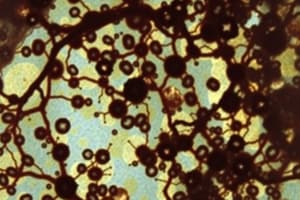Podcast
Questions and Answers
What protein type is associated with the membranes' surface and does not penetrate the bilayer?
What protein type is associated with the membranes' surface and does not penetrate the bilayer?
- Peripheral Proteins (correct)
- Channel Proteins
- Transmembrane Proteins
- Integral Proteins
Which process requires energy to transport molecules across a membrane?
Which process requires energy to transport molecules across a membrane?
- Facilitated Diffusion
- Simple Diffusion
- Active Transport (correct)
- Passive Transport
What is the primary function of the cell membrane?
What is the primary function of the cell membrane?
- Store nutrients and pigments
- Produce energy for the cell
- Control movements of substances in and out of the cell (correct)
- Protect the cell from UV radiation
What is the main function of the glycocalyx on the cell membrane?
What is the main function of the glycocalyx on the cell membrane?
What is the composition of the phospholipid bilayer?
What is the composition of the phospholipid bilayer?
Which of the following statements is true regarding organelles?
Which of the following statements is true regarding organelles?
Which type of endocytosis involves the uptake of large particles, such as bacteria?
Which type of endocytosis involves the uptake of large particles, such as bacteria?
What structural feature is characteristic of mitochondria?
What structural feature is characteristic of mitochondria?
How does the cell membrane appear under high magnification in an electron microscope?
How does the cell membrane appear under high magnification in an electron microscope?
Which component is NOT a part of the cell nucleus?
Which component is NOT a part of the cell nucleus?
Flashcards are hidden until you start studying
Study Notes
Cytology Overview
- Cytology is the study of cells, which are the fundamental units of structure and function in organisms.
- Cells consist of a cell membrane (plasmalemma) and protoplasm, which includes cytoplasm and nucleus.
Cell Structure
- Cell Membrane Functions:
- Maintains cell integrity
- Controls substance exchange (selective permeability)
- Recognizes antigens and foreign cells
- Protoplasm Components:
- Cytoplasm: Contains cytosol, organelles, and inclusions
- Cytosol: Semifluid matrix
- Organelles: Active structures crucial for cell function
- Inclusions: Nutrient storage, not essential for life
- Nucleus Components:
- Nuclear envelope, nucleolus, chromatin, nuclear matrix
- Cytoplasm: Contains cytosol, organelles, and inclusions
Microscopy Techniques
- Light Microscope:
- Ordinary stains highlight cell features (e.g., hematoxylin for basophilia, eosin for acidophilia).
- Electron Microscope:
- Provides greater detail; distinguishes electron-dense (dark) and electron-light (lucent) structures.
Cell Membrane Details
- Molecular Structure:
- Fluid-mosaic model includes phospholipid bilayer, cholesterol, and proteins
- Phospholipids:
- Form double layers with polar (hydrophilic) heads and non-polar (hydrophobic) tails.
- Membrane Proteins:
- Integral Proteins: Embedded in the lipid bilayer
- Peripheral Proteins: Associate with the bilayer's surface
Membrane Transport Mechanisms
- Passive Transport:
- Moves substances based on concentration gradient without energy
- Active Transport:
- Moves substances against concentration gradient; requires energy (e.g., sodium-potassium pump)
- Vesicle-Mediated Transport:
- Endocytosis:
- Cell intake of substances (e.g., phagocytosis for solids, pinocytosis for fluids)
- Exocytosis:
- Release of substances from the cell
- Endocytosis:
Mitochondria
- Membranous organelles crucial for energy production
- Found in all cells except mature red blood cells
- Composed of:
- Outer Membrane: Smooth, no selective permeability
- Inner Membrane: Folded into cristae; site of ATP production via oxidative phosphorylation
- Matrix: Contains enzymes, ribosomes, RNA, DNA, and Ca²⁺ ions.
- Functions:
- ATP synthesis
- Calcium regulation and detoxification
Ribosomes
- Non-membranous organelles key for protein synthesis
- Present in all cells except mature erythrocytes
- Types:
- Free Ribosomes: Scattered in cytoplasm, synthesize internal proteins
- Attached Ribosomes: Bound to rough endoplasmic reticulum (rER), synthesize secretory proteins
- Structure contains rRNA and proteins; visible only under EM as small particles.
Endoplasmic Reticulum (ER)
- Two types:
- Smooth ER (sER): Lacks ribosomes, involved in lipid synthesis, detoxification, and calcium regulation
- Rough ER (rER): Studded with ribosomes; synthesizes secretory and membrane proteins
- Continuous network essential for cellular functions.
Golgi Apparatus
- Membranous organelle involved in protein processing
- Consists of stacks of flattened cisternae
- Functions include:
- Protein modification (glycosylation, sulfation)
- Concentrating and packaging proteins and lysosomes
- Membrane recycling with the plasma membrane
Lysosomes
- Membranous organelles containing hydrolytic enzymes
- Classified into:
- Primary Lysosomes: Newly formed, homogeneous contents
- Secondary Lysosomes: Heterogeneous contents formed from fusion with vesicles (e.g., phagosomes, autophagosomes)
- Act as intracellular digestive systems; release contents via exocytosis.
Studying That Suits You
Use AI to generate personalized quizzes and flashcards to suit your learning preferences.




